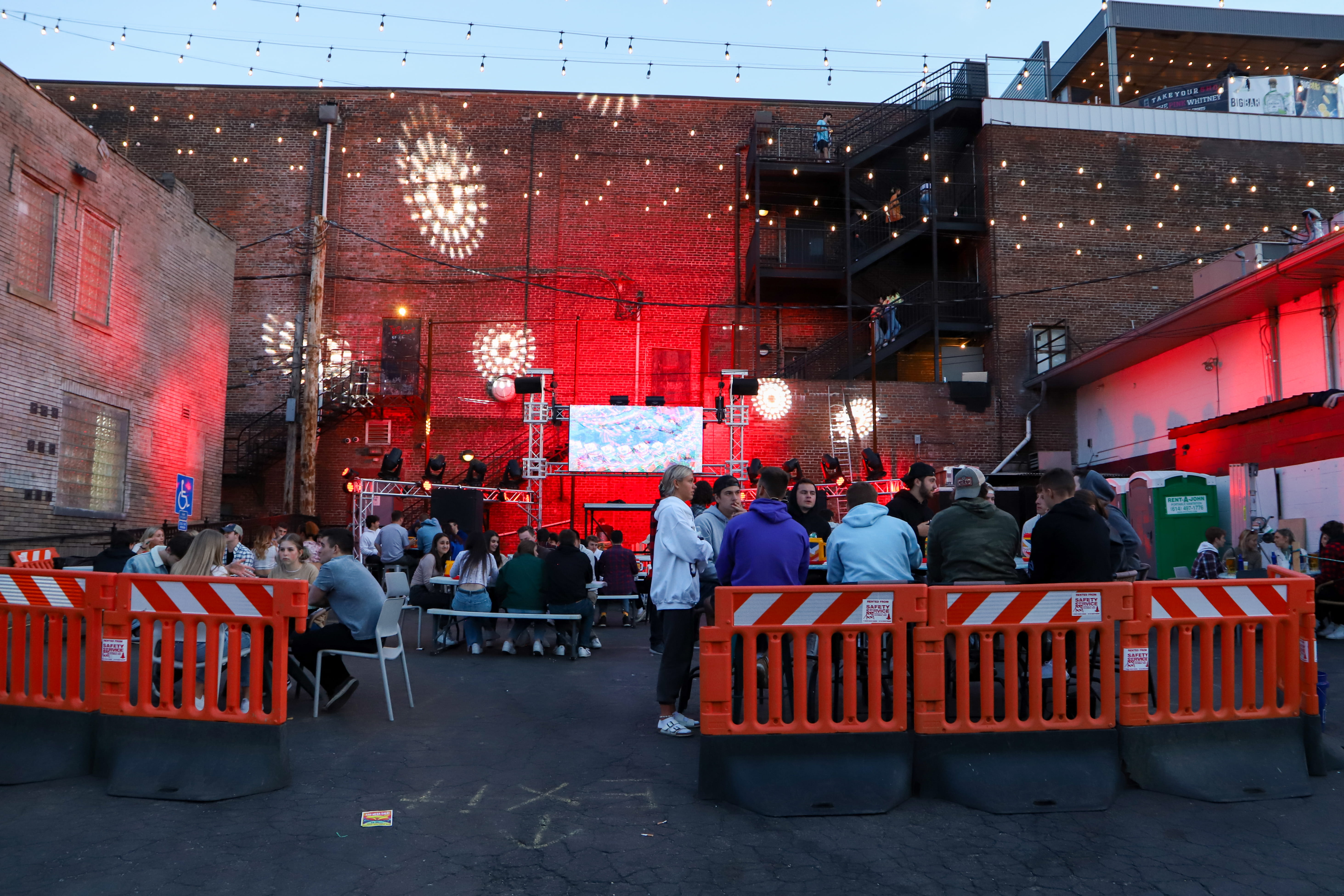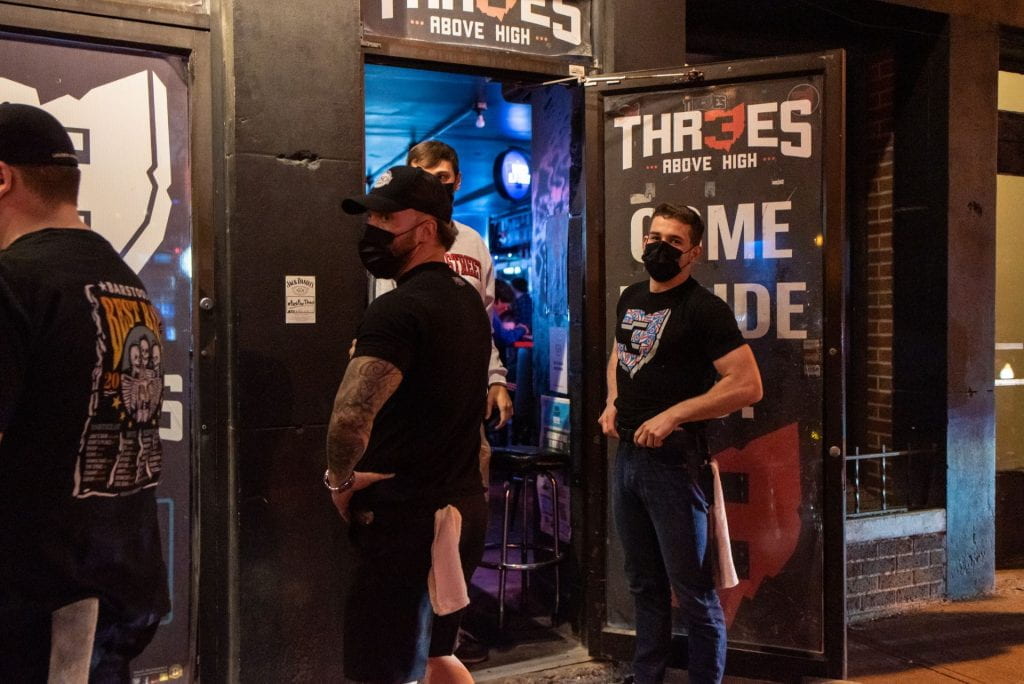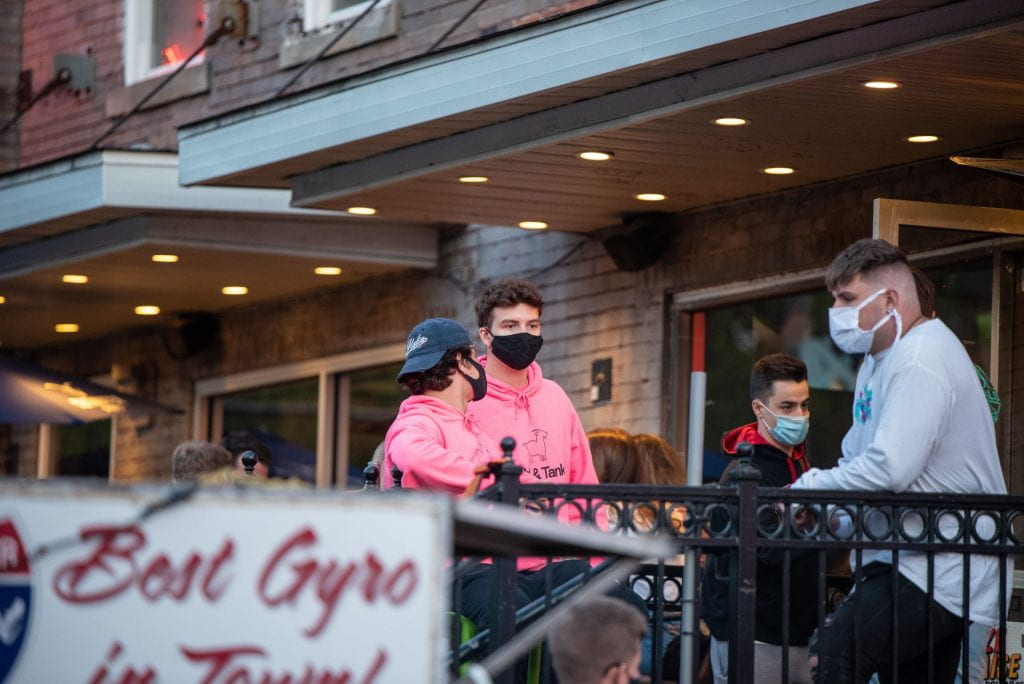Fake IDs find popularity regardless of legal and university consequences
Students typically enter college around the age of 18 but for some, party culture cannot wait until they come of drinking age. Fake IDs, described by one student as ‘very versatile social tools,’ allow them to circumvent drinking laws, entering bars and purchasing alcohol before they turn 21.

Midway sits on High Street in Columbus and many students from Ohio State frequent the bar on the weekend using fake IDs.
Mackenzie Shanklin|Photo Editor
Published April 29, 2021
Bars near college campuses don’t exclusively attract those of legal drinking age.
A Lantern survey of 246 Ohio State students found that about 69 percent claim to have used or owned a fake ID. Students further shared first hand-experiences of using fake IDs and locations where they feel most comfortable using them based on the leniency of the ID-checking procedure at campus-area bars.
The top five bars where students said they feel most comfortable using their fake IDs are Bullwinkles, Midway, Cazuela’s Grill, Threes Above High and Ethyl & Tank.
We got fake IDs as a group my first year of undergrad that were used for until we turned 21. There are certain bars that are notorious for letting in underage students.
Students typically enter college around the age of 18, making them underaged for their first few years at Ohio State. Fake IDs allow students to circumvent drinking laws — entering bars and purchasing alcohol before their 21st birthday.
There are two main methods of obtaining a fake ID: purchase it online or use someone else’s legitimate ID if they have similar characteristics. Fake IDs can be purchased online or more locally from Ohio sellers and often in bundle packs.
The Ohio Investigative Unit, a branch of the Ohio State Highway Patrol, investigates and sometimes busts manufacturers of fake IDs.
Some bars, such as Threes Above High, instituted a two-ID policy in an attempt to deter the use of fake IDs. Still, Threes ranked fourth among bars where students feel comfortable using their fake IDs.
Although the methodology for rooting out fake IDs varies by location, bar staff up and down High Street agree that fakes are made with increasingly higher quality — making them harder to detect.
Fake IDs are not new, and some would argue they serve as a right of passage in college. But if caught with a fake ID, students could face penalties from the university and law enforcement alike.
![[1] Fake IDs](https://www.thelantern.com/projects/files/2020/02/1-Fake-IDs.png)
Ivan Kostovski|Infographics Editor
Where students buy fake IDs
At about $60 a pop, one Ohio State student, who spoke under conditions of anonymity, said he went in on a bundle of fake IDs from a popular seller, IDGod.com, with friends freshman year. His ID, which came with a backup, falsely stated he was from West Virginia, but other identifiers including his height and weight were accurate so he could recite them at a bar without raising suspicions.
He said it can be challenging to find a good website and provide all the required information to order a fake ID, but thinks it was worth the effort. Without the fake ID, the student said he would have had to rely on other people to purchase alcohol for him.
I think in general Ohio State campus is very lenient on fake IDs, especially in comparison to other college campuses.
“It definitely can be a little bit of a hefty process to get it, it’s definitely not the easiest thing, but it is very much well worth it in terms of just sociability,” he said.
In addition to purchasing alcohol, the student said the fake ID allowed him to access bars with friends who were upperclassmen.
“Having a fake ID really actually enhanced my social life,” he said.

Patrons sit in the outdoor space designated between Midway and Ethyl & Tank on High Street.
Mackenzie Shanklin|Photo Editor
Where students use fake IDs
When freshmen arrive at Ohio State, word on the street — or in the dorms — distinguishes which dining halls have the best ice cream from those that might give you food poisoning. Similar whispers clue newcomers into which campus-area bars are most accepting of fake IDs.
Armed with a fake ID, students must then determine which bars or stores are least likely to challenge it.
The student said he never had his fake ID rejected at a campus-area bar or store. He said Bulls, a nickname for Bullwinkles, Midway, The Library Bar and Threes Above High are known for leniency, whereas Ethyl & Tank and Leo’s on the Alley are more strict. In general, he said “cheaper” bars are more likely to accept a fake ID.
Midway, which students rated the second-best place to use a fake ID, has a few different ways to check for fake IDs at the door. Ryan Hensley, a manager at Midway, said bouncers undergo two types of training.
First, they are trained using an “ID book” that serves as a guide for telltale signs of an illegitimate ID such as being able to bend the card. He said new door guys also spend a minimum of two to three shifts with a seasoned bouncer to learn how to properly check IDs.
Apart from looking at the ID with a plain eye, bouncers at Midway may use UV flashlights that shine distinctively through a fake ID. Hensley said the bar previously used ID scanners to root out fakes but stopped the practice since many fake IDs scan nowadays.
“It’s not as foolproof. In fact, it’s more open to loopholes,” he said.
Although students may feel comfortable using a fake ID at Midway, Hensley said the bar confiscates about 15-20 fakes per night during non-pandemic times. On April 16, Midway bouncers had already collected three fake IDs before 8:30 p.m.: two from out of state and one from Ohio.

The back of an Ohio ID which is one of the way bouncers identify fakes that are brought to the bar.
Mackenzie Shanklin|Photo Editor
Hensley said Ohio law requires bars to confiscate Ohio IDs they deem fake. If someone presents a fake ID from another state, Hensley said Midway will more often just turn the person away.
“It’s your due diligence to know the IDs of your state. However, it’s very difficult to expect not just our bar but every bar in the world, for every bartender to be able to correctly identify 50 IDs,” he said.
If a bar is found to have permitted patrons with a fake Ohio ID, Hensley said it will face greater disciplinary consequences than they would for out-of-state fake IDs.

A security guard stands at the entrance of Midway on High Street in Columbus.
Christian Harsa|Asst. Photo Editor
Ohio law actually does not require bars to confiscate IDs they suspect are fake. Eric Wolf, enforcement commander for the Ohio Investigative Unit who investigates ID fraud, said he would deter bars from confiscating IDs in case they are legitimate because they are considered personal property.
“If they happen to seize an ID that is in fact valid and not fictitious, that they could potentially be civilly liable,” Wolf said.
Wolf said the Ohio revised code does include a “good faith” rule for checking fictitious identifications, which requires bars to take a few baseline steps such as checking that the ID shows the person is over 21 years old, that they match the photo on the document and making any additional efforts to verify it’s legitimate, such as asking questions about birthdate or home address. If a clerk or bartender meets these requirements, they would not be held liable if an individual is found to be underaged.
“If the fake ID looks good and they take the time to make the bonafide effort to make sure the person standing in front of them is in fact the person represented on the ID, then they could potentially be protected from any penalties from the liquor control commission,” Wolf said.
Ultimately, Wolf said the Ohio Liquor Control Commission has the final authority to determine penalties in underaged drinking cases.

Bouncers stand outside Threes Above High on High Street in Columbus and look at IDs as students and patrons enter the bar.
Christian Harsa|Asst. Photo Editor
Threes Above High, a bar located just north of campus, requires two forms of identification to gain entry. A secondary form of ID must verify the individual’s name and may include a student ID or other form. Scott Ellsworth, the owner of Threes Above High, said the bar instituted the policy because of the high frequency of undercover police in the campus area.
Ninety-seven students said they feel comfortable using a fake ID at Threes Above High in the Lantern survey.
Dearest children of campus,
— THR3ES ??❤️ (@threesabovehigh) February 22, 2020
If you’re going to use a fake id, we strongly suggest you not brag about it to a stranger in line. Because wouldn’t it suck if that stranger turned out to be an undercover cop?! Yeah that happened. Smh
Love,
Dad
Ellsworth said he doesn’t want students to get in trouble and “have something stupid like an underage on their record.” He said the two-ID policy also shows the state of Ohio that the bar is taking an extra step.
“Ultimately, if we ID everyone, like we do, we’ve done our job. Our staff aren’t FBI agents that can spot a fake ID, especially when they’re made so well nowadays,” Ellsworth said in a text message.
When asked whether he thinks other bars should institute the two-ID policy, Ellsworth said, “we are a close-knit group and we know they’ll always do what’s best for their business.”
Legal consequences
The student said his biggest concern with using a fake ID is that it might be confiscated. Although his ID was never taken, he said he has been turned away at the door by out-of-state establishments that recognized it wasn’t legitimate.
He said if his fake IDs were confiscated before he turned 21, he would have found it worthwhile to order another.
“The worst that they could do is just take your ID away. Or what they’ll do is be like, ‘No,’ and just won’t let you in,” the student said.
Lost mine on campus and campus security found it and nearly got sent to the misconduct board
Confiscation actually isn’t the worst that could happen, though. Penalties for being caught entering an establishment and drinking underage may range from license suspensions and fines to jail time, Wolf said.
Students may also face disciplinary actions with Ohio State. Since 2015, 6,133 students have been charged for violations to section I of the Code of Student Conduct or the Residential Living Handbook and violations to the university’s Alcohol and Other Drugs Policy, including underaged drinking, false identification and state sanctions.
“Ohio State expects all members of our community to follow the law. Students who choose to drink should do so safely and responsibly, and in accordance with the law,” university spokesperson Ben Johnson said.
Profit incentive for accepting fake IDs
Since first- and second-year students are typically under the age of 21, some campus-area bars may be incentivized to accept fake IDs to increase their business among the college crowd. Wolf said each establishment has a tradeoff between shouldering the liability for allowing underage people to enter and consume alcohol versus improving profit.
Still, he said he thinks enforcement of underage drinking laws by University Police, Columbus Police and the OIU is enough to deter bars from the profit incentive of permitting underage drinking. He said some bars even pride themselves on not allowing underaged people to enter or consume alcohol.

A bouncer and security personnel sit outside the door for Ethyl & Tank looking at IDs of patrons as they enter.
Christian Harsa|Asst. Photo Editor
Fake ID manufacturing
Once a student receives their fake ID in the mail, they may not think twice about the supply chain that provided it. Behind the scenes, the Ohio Investigative Unit is tasked with finding and stopping the sellers of false identification documents.
The unit operates within Ohio, which means fake IDs that originate from websites overseas are out of its jurisdiction. In these instances, the OIU passes cases on to other agencies. In recent years though, the OIU has located and charged Ohio-based fake ID operations.
On Oct. 22, 2015, an employee at McMurray’s Pub in Springfield, Ohio, collected a few fake IDs and alerted authorities. Agents gathered the IDs, two of which appeared to be Ohio driver’s licenses.
On Oct. 27, 2015, agents interviewed a student at Wittenberg University who said he gave his friend money to purchase fake IDs off of Reddit. Agents explored the Reddit thread and found posts about a person who specializes in making fake Ohio IDs, allowing customers to pay via bitcoin and discretely mailing the IDs.
The seller, a vendor on Reddit, had the username “TedDanzigSR” and through a quick Google search, agents found a YouTube video demonstrating the quality of the fake IDs.
On Jan. 12, 2016, agents used a fictitious email address to purchase the first of many IDs throughout the investigation from the seller for 0.7704 Bitcoin — or $310 — according to the incident report. The order was also placed under a fictitious name and a covert address.
The fake Ohio driver’s license arrived taped between two baseball cards. Agents were not immediately able to determine a return address but narrowed the sender’s location down to the Toledo, Ohio, area through an IP address, according to the incident report.
The person behind TedDanzigSR, revealed as Mark Simon, was a postgraduate student at the University of Toledo. He had previously sold IDs on a dark web market called Silk Road before the site was shut down by the federal government in 2013. In 2014, he created a new website that could only be accessed through a certain browser, concealing an individual’s identity online, according to the incident report.
Agents gained access to TedDanzigSR’s Reddit records and monitored his posts, revealing both public and private messages. Among these messages were correspondence between TedDanzigSR and another fake ID vendor about manufacturing operations and the number of people each supplier employs.
According to the incident report, only 10 percent of the IDs from TedDanzigSR stayed in Ohio and the rest shipped nationwide.
In addition to Simon, agents investigated three other individuals — Ben Stalets, Sarah Alberts and Aaron Kuns — believed to be involved in the operation. They arranged surveillance, including video cameras outside Simon’s house, to monitor these suspects throughout the investigation.
Agents also tracked deliveries to each of the suspects. Shipments included printing equipment, gloves, magnetic stripe encoders and baseball cards, according to the incident report. Ultimately, officers and troopers of the OIU, United States Secret Service and local police departments executed search warrants in each of the residences and found Bitcoin, burner phones, mailing supplies and ID manufacturing equipment, according to the incident report.
After more than two years of investigation and surveillance, Simon, Kuns, Alberts and Stalets were found guilty of multiple charges in connection to producing and transferring fraudulent identification documents. Simon was sentenced to two years in prison, Kuns was sentenced to one year in prison, Alberts was sentenced to two months in prison and Stalets was sentenced to two years of probation and 60 days of home confinement.
Cost vs. reward
Much like word of mouth informs which bars are most lenient towards fake IDs, students also become hyperaware of undercover police during certain times of the year, especially the first week of the semester. Wolf said such selective enforcement is not the case, and OIU agents are out year-round looking for fake IDs.
“It’s not concentrated to spring break or first week of the semester or anything of that nature. It’s a constant, pretty steady issue that we deal with,” Wolf said.
Wolf added that on top of the risk to an individual using a fake ID, supplying personal information to furnish the ID itself puts people at risk of identity fraud. Identifying details provided for the ID could be used without the buyer’s knowledge for illicit activities.
“There’s certainly an argument that some of this can be used for other criminal activity or even terrorist activity here in the U.S. or overseas. So there’s just a lot of concerns when you start giving your personal information to companies like that,” he said.
Despite the risk of buying and using a fake ID, the student said he would recommend one to students who may be on the fence about it.
“They’re great tools to have. Probably one of the better decisions that I made,” he said.
Web Design by Jack Long | Managing Editor for Digital Content

